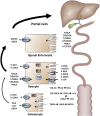Intestinal transport and metabolism of bile acids
- PMID: 25210150
- PMCID: PMC4442867
- DOI: 10.1194/jlr.R054114
Intestinal transport and metabolism of bile acids
Abstract
In addition to their classical roles as detergents to aid in the process of digestion, bile acids have been identified as important signaling molecules that function through various nuclear and G protein-coupled receptors to regulate a myriad of cellular and molecular functions across both metabolic and nonmetabolic pathways. Signaling via these pathways will vary depending on the tissue and the concentration and chemical structure of the bile acid species. Important determinants of the size and composition of the bile acid pool are their efficient enterohepatic recirculation, their host and microbial metabolism, and the homeostatic feedback mechanisms connecting hepatocytes, enterocytes, and the luminal microbiota. This review focuses on the mammalian intestine, discussing the physiology of bile acid transport, the metabolism of bile acids in the gut, and new developments in our understanding of how intestinal metabolism, particularly by the gut microbiota, affects bile acid signaling.
Keywords: enterohepatic circulation; microbiome; nuclear receptors; transporters.
Copyright © 2015 by the American Society for Biochemistry and Molecular Biology, Inc.
Figures


References
-
- Thomas C., Pellicciari R., Pruzanski M., Auwerx J., Schoonjans K. 2008. Targeting bile-acid signalling for metabolic diseases. Nat. Rev. Drug Discov. 7: 678–693. - PubMed
-
- Thomas C., Auwerx J., Schoonjans K. 2008. Bile acids and the membrane bile acid receptor TGR5–connecting nutrition and metabolism. Thyroid. 18: 167–174. - PubMed
Publication types
MeSH terms
Substances
Grants and funding
LinkOut - more resources
Full Text Sources
Other Literature Sources

